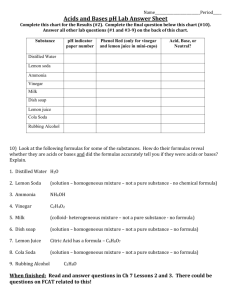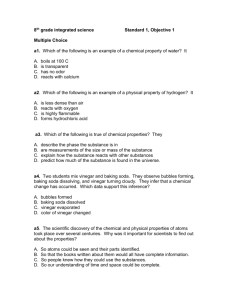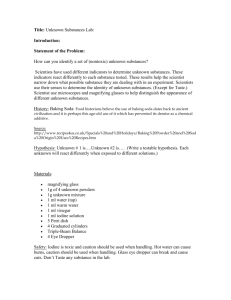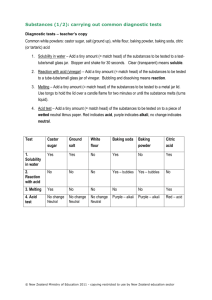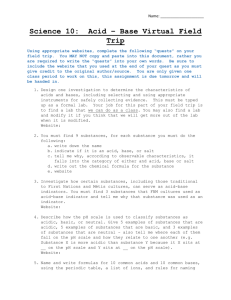Balanced Equations, Reactants, and Products
advertisement
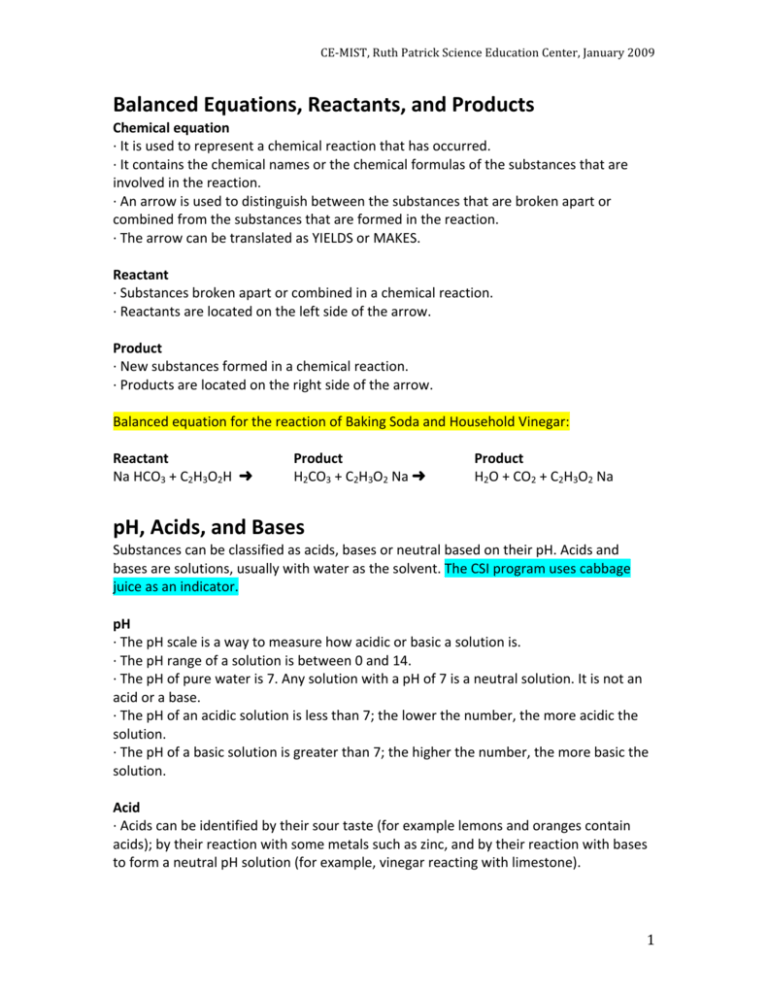
CE‐MIST, Ruth Patrick Science Education Center, January 2009 Balanced Equations, Reactants, and Products Chemical equation ∙ It is used to represent a chemical reaction that has occurred. ∙ It contains the chemical names or the chemical formulas of the substances that are involved in the reaction. ∙ An arrow is used to distinguish between the substances that are broken apart or combined from the substances that are formed in the reaction. ∙ The arrow can be translated as YIELDS or MAKES. Reactant ∙ Substances broken apart or combined in a chemical reaction. ∙ Reactants are located on the left side of the arrow. Product ∙ New substances formed in a chemical reaction. ∙ Products are located on the right side of the arrow. Balanced equation for the reaction of Baking Soda and Household Vinegar: Reactant Product Product Na HCO3 + C2H3O2H ➜ H2CO3 + C2H3O2 Na ➜ H2O + CO2 + C2H3O2 Na pH, Acids, and Bases Substances can be classified as acids, bases or neutral based on their pH. Acids and bases are solutions, usually with water as the solvent. The CSI program uses cabbage juice as an indicator. pH ∙ The pH scale is a way to measure how acidic or basic a solution is. ∙ The pH range of a solution is between 0 and 14. ∙ The pH of pure water is 7. Any solution with a pH of 7 is a neutral solution. It is not an acid or a base. ∙ The pH of an acidic solution is less than 7; the lower the number, the more acidic the solution. ∙ The pH of a basic solution is greater than 7; the higher the number, the more basic the solution. Acid ∙ Acids can be identified by their sour taste (for example lemons and oranges contain acids); by their reaction with some metals such as zinc, and by their reaction with bases to form a neutral pH solution (for example, vinegar reacting with limestone). 1 CE‐MIST, Ruth Patrick Science Education Center, January 2009 Base ∙ Bases can be identified by their bitter taste (for example, unsweetened cocoa has a bitter taste); by its slippery feel (for example, dish detergent) and by its reaction with acids to form a neutral pH solution (for example, an antacid to soothe an acid stomach). Neutral Solution ∙ It is neither an acid nor a base. ∙ For example, pure water is a neutral solution and has a pH of 7. CSI Powder Test Solution pH Sugar 7 Corn starch 7 Aspirin 4 Baking soda 9 Laundry soap 10 Physical and Chemical Changes PHYSICAL CHANGES Physical changes do not change the composition of a substance, only the physical properties. Evidences of a physical change include: Change in state of matter ∙ When a substance changes from one state of matter to another (for example, changing from solid to liquid, from liquid to solid, or from liquid to gas), the composition of the substance remains the same. ∙ Examples of change in state might include: melting of ice cream, hardening of melted wax, or evaporating of water from wet clothes. ∙ When a substance changes directly from a gas to a solid (the forming of frost from water vapor) or from a solid to a gas (dry ice, solid air fresheners) that change of state is called sublimation. This is still a physical change because the composition of the substance remains the same. Change in size or shape ∙ When a substance changes in size or shape (for example, cutting, tearing, dissolving, stretching, or wrinkling), its composition remains the same. ∙ Examples of change in size or shape might include: shredding paper, dissolving sugar in water, stretching a rubber band, wadding up a piece of paper, or denting a piece of metal. CSI Example: Sugar dissolving in water is a physical change. Corn starch, aspirin, and laundry soap have suspended undissolved solids. 2 CE‐MIST, Ruth Patrick Science Education Center, January 2009 CHEMICAL CHANGES Chemical changes result in the formation of one or more new substances with new chemical and physical properties. Evidences that a chemical change may have occurred include: Color change ∙ When a substance changes color, the chemical composition of the substance may have changed (for example, iron turns to a reddish‐brown when it rusts, clothes change color when bleach is added, apples turn brown when they react with oxygen in the air, or marshmallows turn black when burned). ∙ It is possible to have a color change without a chemical change (for example, adding food coloring to water). Temperature change ∙ When a substance is combined with another substance, there may be an increase or decrease in temperature (for example, when wood burns to ash and gases, the temperature increases). ∙ It is possible to have a temperature change without a chemical change (for example, warming of the water in a pond). Formation of a precipitate ∙ When two solutions are combined, they may form a solid substance. This solid substance is called a precipitate and indicates that a chemical change has occurred. ∙ For example when carbon dioxide is combined with aqueous calcium hydroxide (limewater), solid calcium carbonate (chalk) is formed as the precipitate. ∙ The precipitate may be in the form of very small particles, appearing as cloudiness in the solution or as a solid which settles to the bottom of the container. NOTE: This does NOT apply to our CSI lesson! Formation of a gas ∙ When solid or liquid substances are combined, they may form gas bubbles. ∙ The formation of the gas may indicate that a chemical reaction has taken place. For example when vinegar is added to baking soda, it forms carbon dioxide bubbles. ∙ It is possible to form gas without a chemical change (for example, when water is heated to boiling). CSI Example: When vinegar is added to baking soda, it forms carbon dioxide bubbles. The formation of the gas is a chemical change. 3

